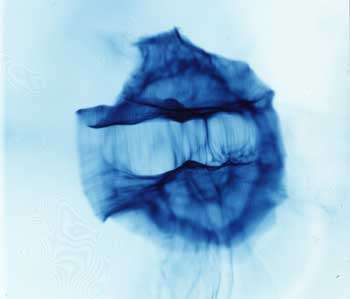Plasmas stream from the top and bottom to form large-scale electromagnetic fields.
(Phys.org)—One of the unsolved mysteries of contemporary science is how highly organized structures can emerge from the random motion of particles. This applies to many situations ranging from astrophysical objects that extend over millions of light years to the birth of life on Earth.
The surprising discovery of self-organized electromagnetic fields in counter-streaming ionized gases (also known as plasmas) will give scientists a new way to explore how order emerges from chaos in the cosmos. This breakthrough finding was published online in the journal Nature Physics on September 30.
"We've created a model for exploring how electromagnetic fields help organize ionized gas or plasma in astrophysical settings, such as in the plasma flows that emerge from young stars," said lead author Nathan Kugland, a postdoctoral researcher in the High Energy Density Science Group at Lawrence Livermore National Laboratory (LLNL). "These fields help shape the flows, and likely play a supporting role alongside gravity in the formation of solar systems, which can eventually lead to the creation of planets like the Earth."
"This observation was completely unexpected, since the plasmas move so quickly that they should freely stream past each other," explained Hye-Sook Park, team leader and staff physicist at LLNL. Park added that "laser-driven plasma experiments can study the microphysics of plasma interaction and structure formation under controlled conditions."
Studying astrophysics with laboratory experiments can help answer questions about astrophysical objects that are far beyond the reach of direct measurements. This research is being carried out as part of a large international collaboration, Astrophysical Collisionless Shock Experiments with Lasers (ACSEL), led by LLNL, Princeton University, Osaka University and Oxford University, with many other universities participating.
More information: "Self-organized Electromagnetic Field Structures in Laser-Produced Counter-Streaming Plasmas" Nature, Sept. 30, 2012 www.nature.com/nphys/journal/v … /full/nphys2434.html
Journal information: Nature , Nature Physics
Provided by Lawrence Livermore National Laboratory




















